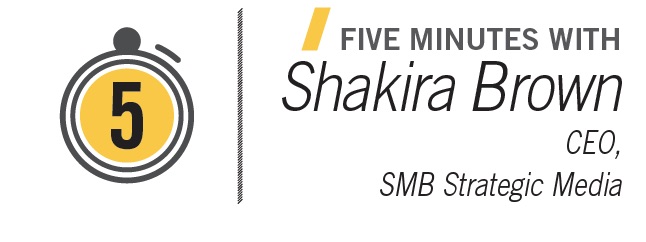Five Minutes With Shakira M. Brown: Responding To Crisis



Shakira M. Brown, a professional speaker, branding and business communication strategist and former network TV journalist, was recently one of the featured speakers during Promotional Product Professionals of Canada’s (PPPC) Natcon Virtual—a virtual trade show held September 16-17—where she presented the session, “Tactical Crisis Communication: Knowing What To Say And When To Say It.” Brown—CEO of SMB Strategic Media, a firm that helps businesses clarify strategic brand messaging, and lead marketing consultant for America’s Small Business Development Center at The College of New Jersey—shared insights from her more than 25 years’ experience working in crisis communication, which included assembling a crisis communications team and appointing a designated a spokesperson, and responding appropriately and promptly to a crisis. Today, businesses of all sizes can be affected by natural disasters, major computer network interruptions and civil unrest that affects employees and clients. PPB spoke with Brown on the need for a crisis communication plan and how to develop it.
PPB When developing a crisis communication plan, what do you believe is the most important focus area of strategy that businesses must home in on first and foremost, and why?
Brown Identifying those who will be responsible for executing the plan, including spokespeople, is very important. If a crisis communication plan exists as a file that is sitting on your server with no real strategy for executing it, having the plan is meaningless. Roles and responsibilities must be established from the outset.
PPB What are the main components of a crisis communication plan that should be in place?
Brown You can break a crisis communication plan down into six elements:
- A detailed plan: outline and explain how your organization will communicate about the crisis and handle the crisis including a purpose, activation criteria and procedures
- Identify your crisis communication team
- Key messages: consider all possible crises your organization could face and develop key messaging to be used in your response
- Internal communications procedures: think through how staff would be reached in a crisis if your building or internal communications were no longer available
- Media contact list for outreach on the fly
- Appendices section including guidelines, checklists and forms that support and facilitate crisis communication
PPB Share with us how businesses can perform a ‘threats analysis’ to identify, anticipate and prepare for potential threats.
Brown The best way to analyze and anticipate threats is to hire a risk management consultant. Why? Because a consultant can have an objective view of your business as a whole without any bias. An internal staffer might not notice risks or even inadvertently cover them up so as not to reveal their own faults. Any promotional products company that is serious about risk management should work with an outside consultant.
PPB Who should be included in the crisis communications team, and how is the spokesperson chosen for that team?
Brown A crisis communication team must start with willing participants. There is no sense in having individuals on the team who may hesitate to execute their responsibilities. If your company has a marketing and communications team, they should take the lead as distribution of information, media inquiries and managing social media. Spokespeople should consist of senior leaders in your organization who have agreed, in advance, to serve in this role. You do not want to be in the middle of your crisis to discover that your chief operating officer has a fear of public speaking. For larger firms with higher risk, having a third-party crisis communication firm or consultant at your disposal will help ensure the plan is executed in the event internal team members are unavailable. Bottomline: staffers in various roles can be tapped to participate on the crisis communication team based on their potential need to be involved with the myriad crises your organization may face.
PPB Can you share with us the significance of video, in particular, when responding to a crisis?
Brown When it comes to communicating with the public regarding a crisis matter, being able to do so with a measured yet authentic response is key. Recording a video with your spokesperson to address the matter in a clear and calculated way allows you to be very deliberate with your messages—it also removes questions to be asked on the spot. If you have the tools in place—and by tools I mean as simple as a high-end smartphone, good lighting and a means to edit the video—you can record a video with ease. Video is most useful when you are dealing with a simple business interruption, not for catastrophic events, in which case I would recommend a live public statement with a consideration for taking questions, if feasible.
–––––––––––––––––––––––––––––––––––––––––––––––––––––––––––
Danielle Renda is associate editor of PPB.

